A little history
As we have previously seen, Porsche left sportscar racing after 1971. The German company would not totally abandon endurance racing though, but rather concentrate its efforts on GTs. Successive evolutions led to the turbocharged 935, a car that didn’t have much in common anymore with the road-going 911. Endurance racing was now competed by Group 5 (GTs) and Group 6 (sportscars) machines, hence the name of Porsche’s thoroughbred: “930” engine type + Group “5” = “935”. But for 1976, Stuttgart announced a new car satisfying the rules of the fastest class: with a similar engine, but classified as a Group 6, the new entrant was logically called the “936”.
Though a brand new car, the 936 relied heavily on Porsche’s long experience in endurance racing. The engine, as we said, was the trusted 930, a 2.1-litre flat six which offered 540 hp thanks to a single turbocharger. A 1.4 handicap ratio being imposed on supercharged cars' displacements, the 936 was therefore just under the 3.0-litre limit.
This engine was fitted to a chassis that was closely derived from the 917’s, the last sportscar Porsche had built at the time. Many other elements were borrowed from its predecessor, so from the very start, and despite some resemblance, the 936 had more to do with the prototypes of the previous generation than with the 908, still entered then by private teams. From the very start, Porsche decided to limit the 936’s production to a handful of machines that were all reserved for the (virtually) works equipe, the Martini Racing Team. Its intention was to force private teams into purchasing its 935. Those who still wanted to race a Porsche in Group 6 would have to contend themselves with updated 908s.
From their very first outing the 936s proved the cars to beat on the depressed endurance stage of the mid-Seventies. Ageing Mirages and under-funded Lolas couldn’t do much to contest Porsche’s supremacy. Only Alpine’s cars, thanks to Renault’s full support, could match their German rivals. During 1976 they still lacked preparation, but a gallant fight was expected at Le Mans in 1977. Porsche won, but Alpine returned with a vengeance for the 1978 event when, from the very start, Porsche found that its scheduled pace was about ten seconds per lap slower than Alpine’s. Alas, the French team's triumph would lead nowhere as Renault announced its withdrawal from endurance racing at the end of the season, with the intention of concentrating on Formula One.
Without rival, Porsche limited its efforts during the two following seasons. Its 936s all had to retire during the 1979 Le Mans, but its 935 GTs saved the day. In 1980, Jean Rondeau’s handmade prototype gave France its first overall victory at Le Mans in three decades, beating the weak German attempt. Porsche finally reacted in 1981, revamping its old 936 and fitting it with a 2.6-litre engine. This more serious try brought restored success in the Sarthe for the German brand which, from the car's introduction to that point, had won all world championships for makes...
For 1982, Group C cars were introduced by new regulations. Porsche was ready with its 956, powered by the 2.6-litre engine first tested by the 936. As Stuttgart’s management decided to reserve the 956 to its works team during its inaugural season, private teams received 936s they updated and re-bodied in order to fit the new rules. By 1983 though, the 956 was put on sale, and many teams placed orders, discarding their older machines. The 936’s career was at an end, but its glorious successor’s one was just at its onset.
About the models
Altaya successively offered all Le Mans-winning 936s. Here they are:
Model: Porsche 936
Year: 1976
Event: 1976 Le Mans 24 Hours, driven by Jacky Ickx and Gijs Van Lennep (finished 1st overall)
Maker: Ixo
Scale: 1/43
Distributed by: Altaya as no.27 of its Les Monstres Sacrés de l'Endurance press series
Acquired: brand new, in October 2007, in Souillac, France
Correct reproduction, average quality. As with the two following models, some minor problems with the decals, but nothing easily noticeable. My rating is 12/20.
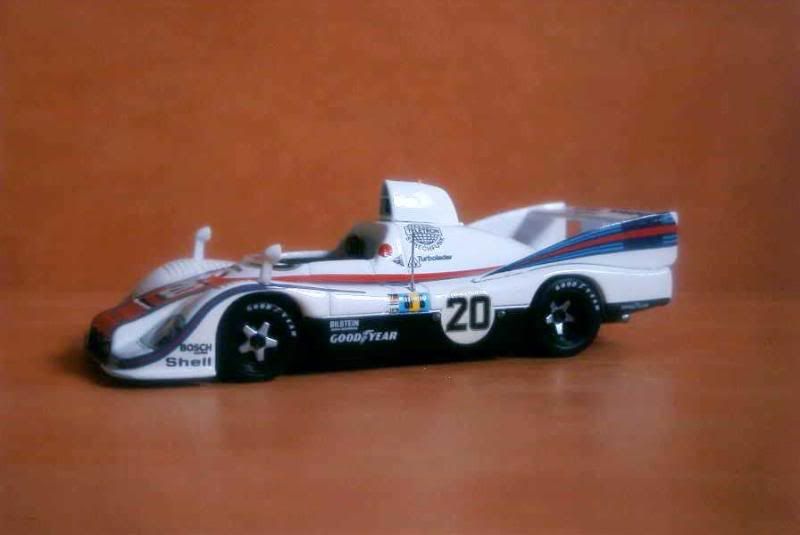
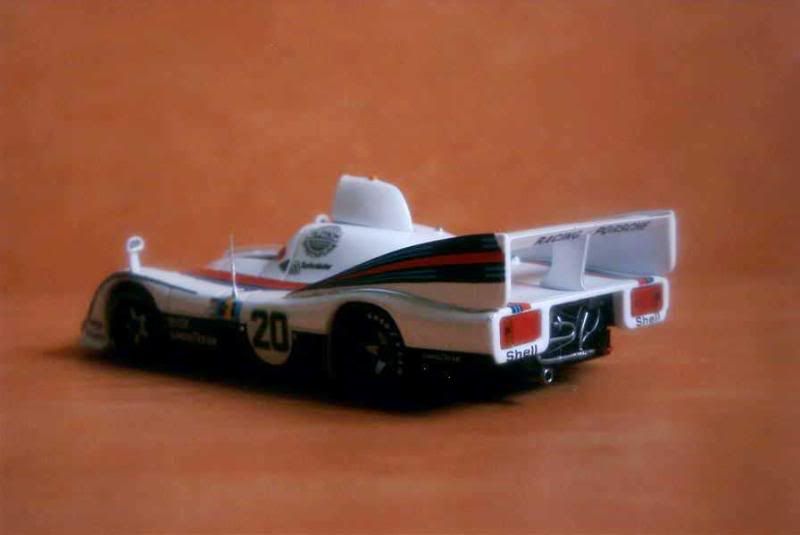
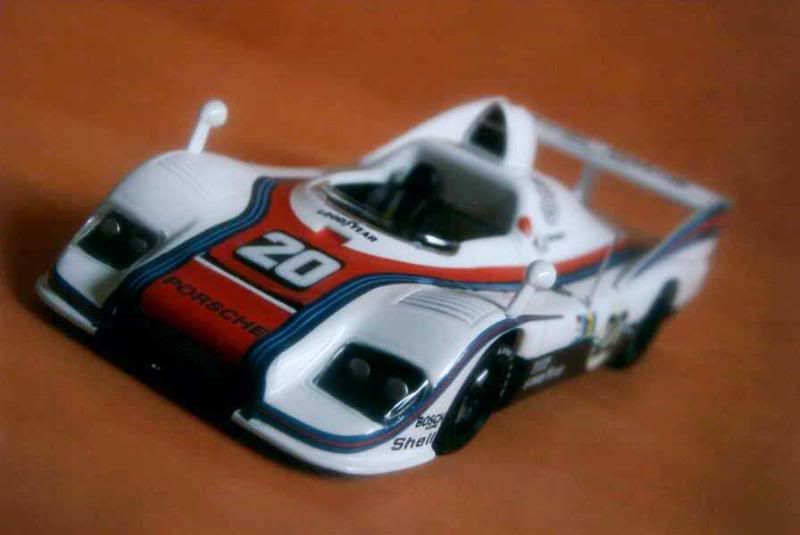
Model: Porsche 936/77
Year: 1977
Event: 1977 Le Mans 24 Hours, driven by Jürgen Barth and Hurley Haywood, relieved by Jacky Ickx (finished 1st overall)
Maker: Ixo
Scale: 1/43
Distributed by: Altaya as no.40 of its Les Plus Belles Voitures des 24 Heures du Mans press series
Acquired: brand new, in September 2005, in Souillac, France
A pleasant model, though the decals are not always well positioned and the headlights are perhaps over-simplified. My rating is 13/20.
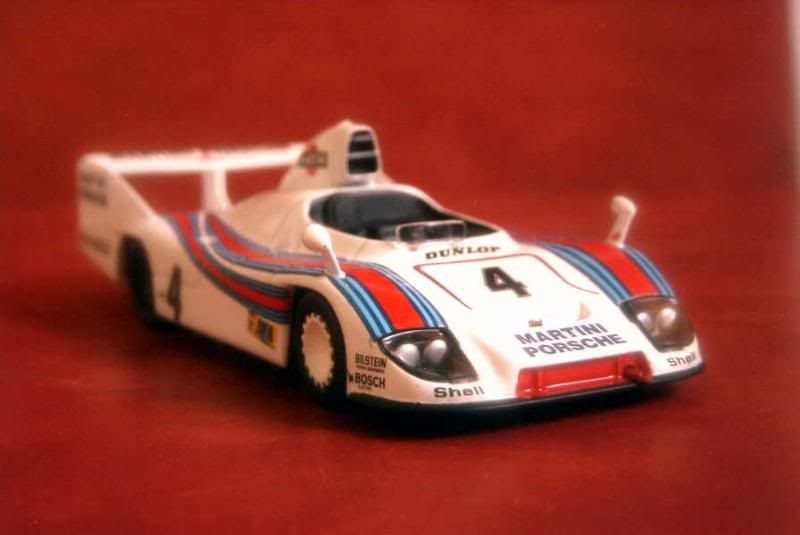
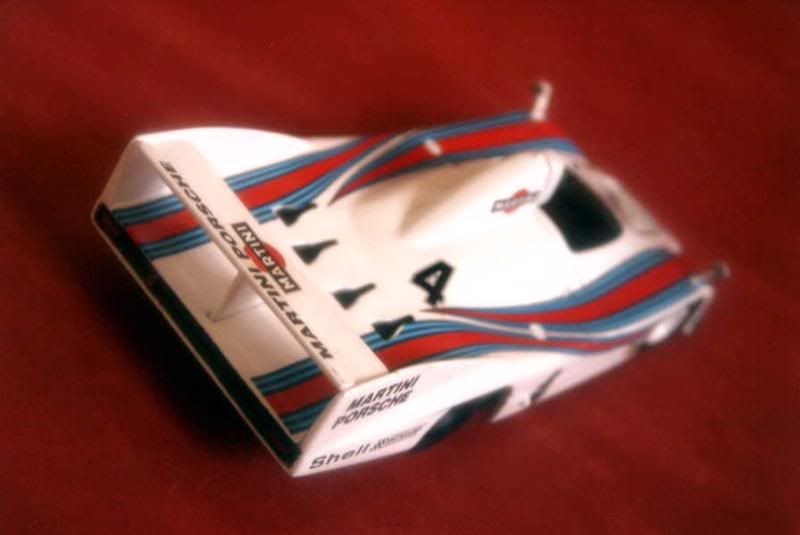
Model: Porsche 936/81
Year: 1981
Event: 1981 Le Mans 24 Hours, driven by Jacky Ickx and Derek Bell (finished 1st overall)
Maker: Ixo
Scale: 1/43
Distributed by: Altaya as no.14 of its Les Plus Belles Voitures des 24 Heures du Mans press series
Acquired: brand new, in March 2004, in Souillac, France
Porsche gave up its traditional "Martini" colours for a "Jules" décor - Jules being the name of a perfume for men at the time. This decoration is as busy as the previous one, and therefore gives as many opportunities to Ixo workers to leave small mistakes behind. On the other hand, the wheels are nice, the headlights better and a metal antenna has been fitted rather than the ordinary plastic ones, that can be so easily broken. I'd give 13/20.
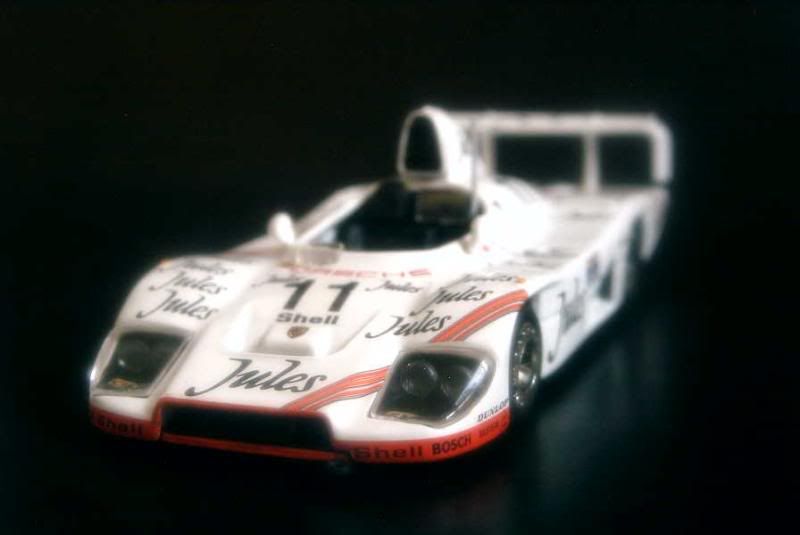

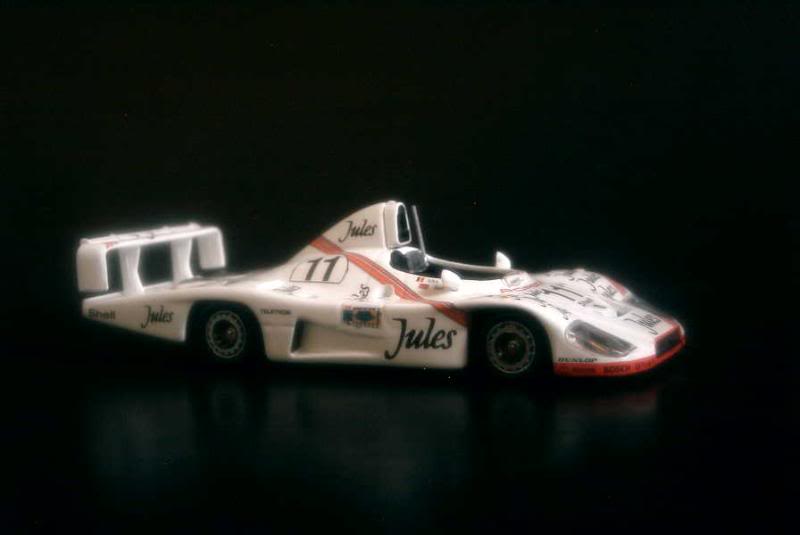
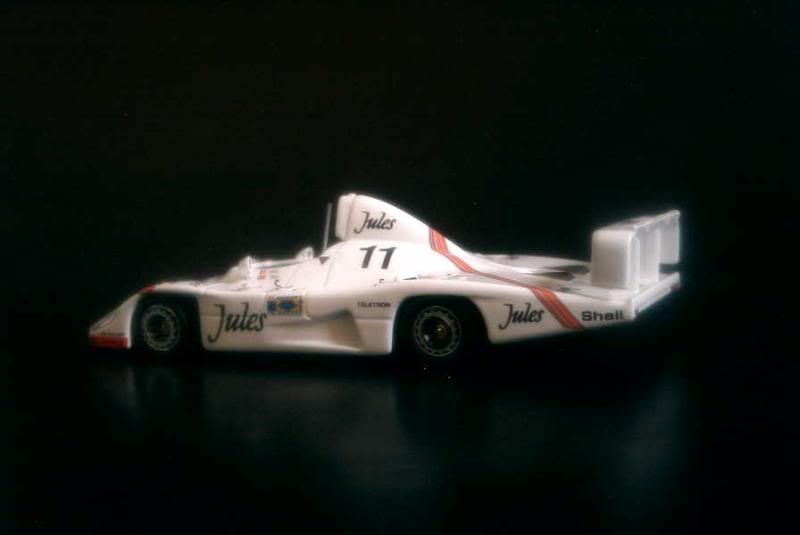

As we have previously seen, Porsche left sportscar racing after 1971. The German company would not totally abandon endurance racing though, but rather concentrate its efforts on GTs. Successive evolutions led to the turbocharged 935, a car that didn’t have much in common anymore with the road-going 911. Endurance racing was now competed by Group 5 (GTs) and Group 6 (sportscars) machines, hence the name of Porsche’s thoroughbred: “930” engine type + Group “5” = “935”. But for 1976, Stuttgart announced a new car satisfying the rules of the fastest class: with a similar engine, but classified as a Group 6, the new entrant was logically called the “936”.
Though a brand new car, the 936 relied heavily on Porsche’s long experience in endurance racing. The engine, as we said, was the trusted 930, a 2.1-litre flat six which offered 540 hp thanks to a single turbocharger. A 1.4 handicap ratio being imposed on supercharged cars' displacements, the 936 was therefore just under the 3.0-litre limit.
This engine was fitted to a chassis that was closely derived from the 917’s, the last sportscar Porsche had built at the time. Many other elements were borrowed from its predecessor, so from the very start, and despite some resemblance, the 936 had more to do with the prototypes of the previous generation than with the 908, still entered then by private teams. From the very start, Porsche decided to limit the 936’s production to a handful of machines that were all reserved for the (virtually) works equipe, the Martini Racing Team. Its intention was to force private teams into purchasing its 935. Those who still wanted to race a Porsche in Group 6 would have to contend themselves with updated 908s.
From their very first outing the 936s proved the cars to beat on the depressed endurance stage of the mid-Seventies. Ageing Mirages and under-funded Lolas couldn’t do much to contest Porsche’s supremacy. Only Alpine’s cars, thanks to Renault’s full support, could match their German rivals. During 1976 they still lacked preparation, but a gallant fight was expected at Le Mans in 1977. Porsche won, but Alpine returned with a vengeance for the 1978 event when, from the very start, Porsche found that its scheduled pace was about ten seconds per lap slower than Alpine’s. Alas, the French team's triumph would lead nowhere as Renault announced its withdrawal from endurance racing at the end of the season, with the intention of concentrating on Formula One.
Without rival, Porsche limited its efforts during the two following seasons. Its 936s all had to retire during the 1979 Le Mans, but its 935 GTs saved the day. In 1980, Jean Rondeau’s handmade prototype gave France its first overall victory at Le Mans in three decades, beating the weak German attempt. Porsche finally reacted in 1981, revamping its old 936 and fitting it with a 2.6-litre engine. This more serious try brought restored success in the Sarthe for the German brand which, from the car's introduction to that point, had won all world championships for makes...
For 1982, Group C cars were introduced by new regulations. Porsche was ready with its 956, powered by the 2.6-litre engine first tested by the 936. As Stuttgart’s management decided to reserve the 956 to its works team during its inaugural season, private teams received 936s they updated and re-bodied in order to fit the new rules. By 1983 though, the 956 was put on sale, and many teams placed orders, discarding their older machines. The 936’s career was at an end, but its glorious successor’s one was just at its onset.
About the models
Altaya successively offered all Le Mans-winning 936s. Here they are:
Model: Porsche 936
Year: 1976
Event: 1976 Le Mans 24 Hours, driven by Jacky Ickx and Gijs Van Lennep (finished 1st overall)
Maker: Ixo
Scale: 1/43
Distributed by: Altaya as no.27 of its Les Monstres Sacrés de l'Endurance press series
Acquired: brand new, in October 2007, in Souillac, France
Correct reproduction, average quality. As with the two following models, some minor problems with the decals, but nothing easily noticeable. My rating is 12/20.



Model: Porsche 936/77
Year: 1977
Event: 1977 Le Mans 24 Hours, driven by Jürgen Barth and Hurley Haywood, relieved by Jacky Ickx (finished 1st overall)
Maker: Ixo
Scale: 1/43
Distributed by: Altaya as no.40 of its Les Plus Belles Voitures des 24 Heures du Mans press series
Acquired: brand new, in September 2005, in Souillac, France
A pleasant model, though the decals are not always well positioned and the headlights are perhaps over-simplified. My rating is 13/20.


Model: Porsche 936/81
Year: 1981
Event: 1981 Le Mans 24 Hours, driven by Jacky Ickx and Derek Bell (finished 1st overall)
Maker: Ixo
Scale: 1/43
Distributed by: Altaya as no.14 of its Les Plus Belles Voitures des 24 Heures du Mans press series
Acquired: brand new, in March 2004, in Souillac, France
Porsche gave up its traditional "Martini" colours for a "Jules" décor - Jules being the name of a perfume for men at the time. This decoration is as busy as the previous one, and therefore gives as many opportunities to Ixo workers to leave small mistakes behind. On the other hand, the wheels are nice, the headlights better and a metal antenna has been fitted rather than the ordinary plastic ones, that can be so easily broken. I'd give 13/20.








No comments:
Post a Comment